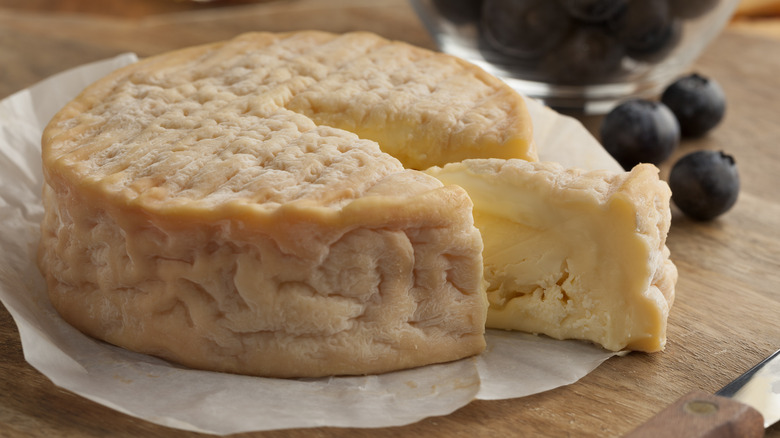The Real Reason Some Cheeses Smell So Bad
If you've ever been exposed to one of the more intensely aromatic cheeses and thought, "that smells like feet," you're not wrong. There is a connection between sweaty, stinky feet and some of the world's stinkiest (and most delicious) cheeses. As it happens, the most odiferous of cheeses, per Food52, belongs to the family of what is known as washed-rind cheeses, a category that includes habitual nostril offenders like Époisses de Bourgogne and limburger.
During the aging process, these cheeses are repeatedly brined, doused in solutions that are mainly saline, but may also be beer or wine-based. The warm, moist conditions of the brine attract bacteria, the most notable of which is Brevibacterium linens (or B linens). It's this bacteria that's primarily responsible for the smelliness of washed-rind cheeses. As Reader's Digest notes, B linens, like the related B epidermis (the bacteria that make your feet or gym socks stinky), both undergo a similar chemical process, changing methionine, which contains sulfur, into methanethiol. Hence, the similarity in odors.
How something can smell that bad, yet taste so good
For those who love these stinky cheeses and have always been curious about how something that so aggressively assails the nostrils can still taste so good ... well, guess what? Science has an answer for this one, too. In the paper "'Taste-Smell Confusions' and the Duality of the Olfactory Sense," published in the journal Perception and Psychophysics in 1982, author Paul Rozin argued that our sense of smell is the "only dual sensory modality." Meaning, there are actually two distinct ways of smelling. There is the whiff one gets of cheese with the nostrils that stinks of feet, but there is also the more pleasant taste and smell of cheese when it's in your mouth. The latter, says Bon Appétit, is called retronasal, or "backwards smelling."
According to Science World, our sense of smell is responsible for up to 80% of what we taste. But our brain perceives smell in two different ways, retronasal and orthonasal (sniffing through the nose). Only one of them, however — retronasal — profoundly affects the way we taste. As Rozin explained: "Adults usually know what sensory system is being stimulated when they experience specific sensations. The most striking exception is ... with substances in the mouth. There is little doubt that what we refer to as mouth-based taste, or flavor, receives its principal distinctive properties from olfaction." Which is to say, our taste comes primarily from smelling the food while it's in our mouth.

